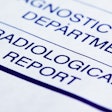
Six factors will influence the recovery in medical imaging procedure volume from the lows caused by the COVID-19 pandemic, according to an article published June 1 in the Journal of the American College of Radiology.
"The COVID-19 pandemic has reduced radiology volumes across the country as providers have decreased elective care in order to minimize the spread of infection and free up health care delivery system capacity," wrote a team led by Dr. Nikhil Madhuripan of Stanford University School of Medicine. "Given the substantial differences in severity and timing of the disease in different geographic regions, estimating resumption of radiology volumes will be one of the next major challenges for radiology practices."
Madhuripan and colleagues listed the following variables they predict will affect radiology volumes as practices recover from the pandemic:
- Severity of disease in the local region, including subsequent waves of infection
- Lifting of government social distancing restrictions
- Patient concern about the risk of leaving home and entering imaging facilities
- Managing demand for imaging delayed during the pandemic's acute phase
- Impact of the economic downturn on health insurance and ability to pay for imaging
- Individual practice profiles, such as amount of elective imaging performed and type of patients seen (emergency/inpatient/outpatient mix and subspecialty types)
"We encourage radiology practice leaders to use these and other relevant variables to plan for the coming weeks and to work collaboratively with local health system and governmental leaders to help ensure that needed patient care is restored as quickly as the environment will safely permit," the group urged.



















